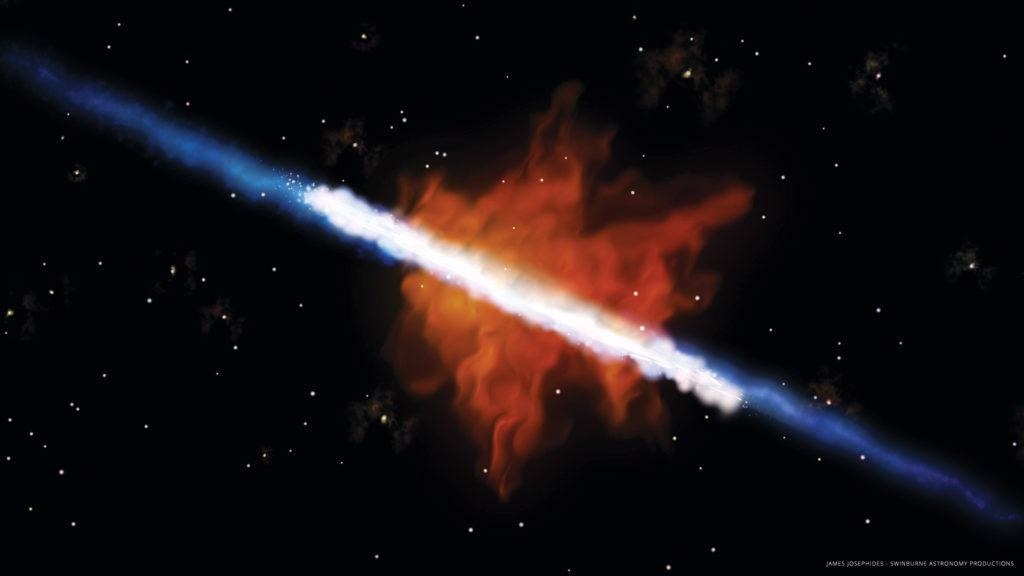Reviewed by Alex SmithAug 31 2021
Under the guidance of Alex Cameron and Deanne Fisher from the ARC Centre of Excellence for All Sky Astrophysics in 3 Dimensions (ASTRO 3D), a group of astronomers has employed a new imaging system at the WM Keck Observatory in Hawaii to verify whether what flows into a galaxy is far cleaner compared to what flows out.
 Galaxies pump out contaminated exhausts. Image Credit: James Josephides, Swinburne Astronomical Productions.
Galaxies pump out contaminated exhausts. Image Credit: James Josephides, Swinburne Astronomical Productions.
The study was published recently in The Astrophysical Journal.
Enormous clouds of gas are pulled into galaxies and used in the process of making stars. On its way in it is made of hydrogen and helium. By using a new piece of equipment called the Keck Cosmic Web Imager, we were able to confirm that stars made from this fresh gas eventually drive a huge amount of material back out of the system mainly, through supernovas.
Deanne Fisher, Study Co-Lead Author and Associate Professor, Centre for Astrophysics and Supercomputing, Swinburne University
“But this stuff is no longer nice and clean — it contains lots of other elements, including oxygen, carbon, and iron,” added Fisher.
The flooding of atoms into galaxies is called “accretion,” and the ultimate expulsion of the atoms is known as “outflows.” Both of these phenomena constitute an essential mechanism controlling the size, mass and growth of galaxies.
Yet, so far, the composition of the inward and outward flows could just be speculated. This study is the first one to confirm the complete cycle in a galaxy apart from the Milky Way.
The scientists focused on a galaxy known as Mrk 1486 to make their findings. This galaxy is located around 500 million light-years from the Sun and has been undergoing a period of very fast star formation.
We found there is a very clear structure to how the gases enter and exit. Imagine the galaxy is a spinning frisbee. The gas enters relatively unpolluted from the cosmos outside, around the perimeter, and then condenses to form new stars. When those stars later explode, they push out other gas—now containing these other elements—through the top and bottom.
Dr Alex Cameron, University of Oxford
Cameron recently moved from the University of Melbourne in Australia to the University of Oxford in the United Kingdom.
The elements from over half the Periodic Table are forged deep within the cores of the stars via nuclear fusion. Upon the collapse of the stars or when they go nova, the effects are propelled into the Universe — where they form part of the matrix from which newer planets, stars, asteroids and, in at least one instance, life emerges.
Mrk 1486 was considered as the ideal candidate for observation since it is located “edge-on” to Earth, implying that the outflowing gas could be viewed easily and its composition has been quantified. A majority of the galaxies are located at awkward angles for this kind of study.
This work is important for astronomers because for the first time we’ve been able to put limits on the forces that strongly influence how galaxies make stars. It takes us one step closer to understanding how and why galaxies look the way they do — and how long they will last.
Fisher, Study Co-Lead Author and Associate Professor, Centre for Astrophysics and Supercomputing, Swinburne University
The other researchers who contributed to the study are from the University of Texas at Austin, the University of Maryland at College Park and the University of California at San Diego — all in the United States — plus the Universidad de Concepcion in Chile.
Journal Reference:
Cameron, A. J., et al. (2021) The DUVET Survey: Direct Te-based Metallicity Mapping of Metal-enriched Outflows and Metal-poor Inflows in Markarian 1486. The Astrophysical Journal. doi.org/10.3847/2041-8213/ac18ca.